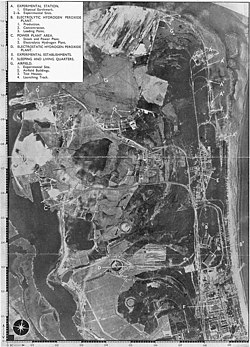Operation Hydra (1943)
| Operation Hydra | |||||||
|---|---|---|---|---|---|---|---|
| Part of Operation Crossbow | |||||||
 British plan for the Peenemünde raid |
|||||||
|
|||||||
| Belligerents | |||||||
| (No. 5, 6, & 8 groups) |
|
||||||
| Commanders and leaders | |||||||
| Group Captain J. H. Searby (Master Bomber) |
Josef Kammhuber, Hubert Weise |
||||||
| Strength | |||||||
|
Hydra: 324 Lancasters, 218 Halifaxes, 54 Stirlings ~1,800 bomb tons, 85% HE. Whitebait: 28 Mosquitos, 10 Beaufighters |
Hydra: 35 fighters including 2 Bf 109 and about 30 Focke-Wulf Fw 190 | ||||||
| Casualties and losses | |||||||
| 215 killed, Hydra: 23 Lancasters, 15 Halifaxes, 2 Stirlings |
4 Bf 110, 1 Do 217, 2 Fw 190, 1 Bf 109, 1 Ju 88, 2 scientists & 732 (mostly Polish) civilians killed 3 men and 1 convict labourer (by 1 bomb from Whitebait). |
||||||
Operation Hydra was a Royal Air Force attack on the Peenemünde Army Research Center on the night of 17/18 August 1943. It was the first time a master bomber was used for the main force. Group Captain John Searby, CO of 83 Squadron, commanded the operation. It began the Operation Crossbow strategic bombing campaign against Nazi Germany's V-weapon programme. 215 British aircrew members and 40 bombers were lost, and hundreds of civilians were killed in a nearby concentration camp. The air raid killed two V-2 rocket scientists and delayed V-2 rocket test launches for seven weeks.
British intelligence sources regarding the V-2 such as the Oslo report, RAF Medmenham photo-reconnaissance photographs, prisoner of war and Polish intelligence, culminated in a pivotal meeting on 29 June 1943 of the Cabinet's Defence Committee (Operations) in the Cabinet War Room.Duncan Sandys MP RA (Churchill's son-in-law), appointed to the investigation in April, opened with an address about the rocket and introduced the aerial photographic reconnaissance images of Peenemünde. Professor Frederick Lindemann followed and expressed weighty arguments regarding an ‘elaborate cover plan’ by the Germans and against the credibility of the reports and the existence of the suspected rocket. After Lindemann's counter-argument, Winston Churchill turned to Reginald Victor Jones who commenced to discredit each of Lindemann's points. The committee recommended avoiding any further Peenemünde aerial reconnaissance flights, which might alert the Germans: "Peenemünde is … beyond the range of our radio navigation beams and … we must bomb by moonlight, although the German night fighters will be close at hand and it is too far to send our own. Nevertheless, we must attack it on the heaviest possible scale" (Churchill, June 29). At 10 Downing St on 15 July, the Chiefs of Staff, Herbert Morrison, Lindemann, and Churchill examined the bombing plan, and the attack was ordered for the earliest opportunity presented by lunar and meteorological conditions.
...
Wikipedia
